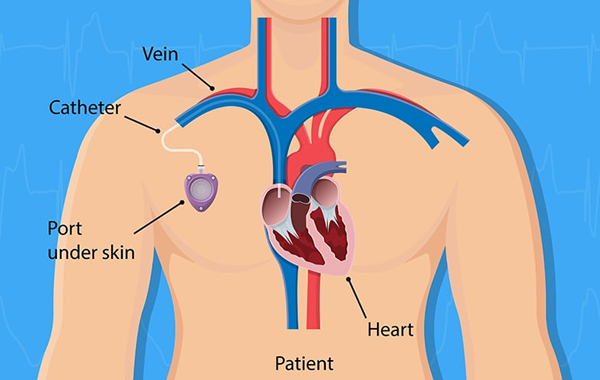Chemoport

A Chemoport is a small medical device implanted under the skin, typically in the chest, for the purpose of administering chemotherapy or other intravenous medications. It is designed to provide easier and safer long-term venous access, reducing the need for repeated needle sticks in veins, which can become difficult after multiple treatments.
Components of a Chemoport:
- Port: A small, round device with a self-sealing silicone top where the needle is inserted.
- Catheter: A thin tube that connects the port to a large vein, usually in the chest or neck.
Common Uses:
- Chemotherapy
- Blood transfusions
- Antibiotic therapy
- Intravenous nutrition
- Blood sample collection
Symptoms and Complications Associated with Chemoport:
- Infection: Redness, swelling, warmth, or discharge at the insertion site may indicate an infection.
- Pain: Mild discomfort or pain around the port after the procedure or during use.
- Blood Clots: The catheter or vein may develop blood clots, leading to swelling, pain, or difficulty using the port.
- Port Malfunction: Sometimes the port may not function correctly, making it difficult to draw blood or infuse medication.
- Thrombosis: Blood clot formation around the catheter.
- Skin Irritation: Tenderness or inflammation over the port site.
Causes for Needing a Chemoport:
- Chronic or Long-term IV Treatment: Conditions like cancer where frequent administration of chemotherapy, medications, or blood draws are needed.
- Fragile Veins: Patients whose veins are difficult to access.
- Frequent Needle Sticks: To reduce the discomfort and complications of frequent IV insertions.
Treatment and Care for Chemoport:
- Maintenance: The chemoport must be flushed regularly (usually with saline and heparin) to keep it open and prevent clotting.
- Infection Prevention: Maintaining cleanliness and proper care around the port area is crucial. Hands should be washed before handling the port, and sterile techniques should be used when accessing it.
- Monitoring for Complications: Patients should be aware of signs of infection, pain, or swelling, and report these to their healthcare team immediately.




